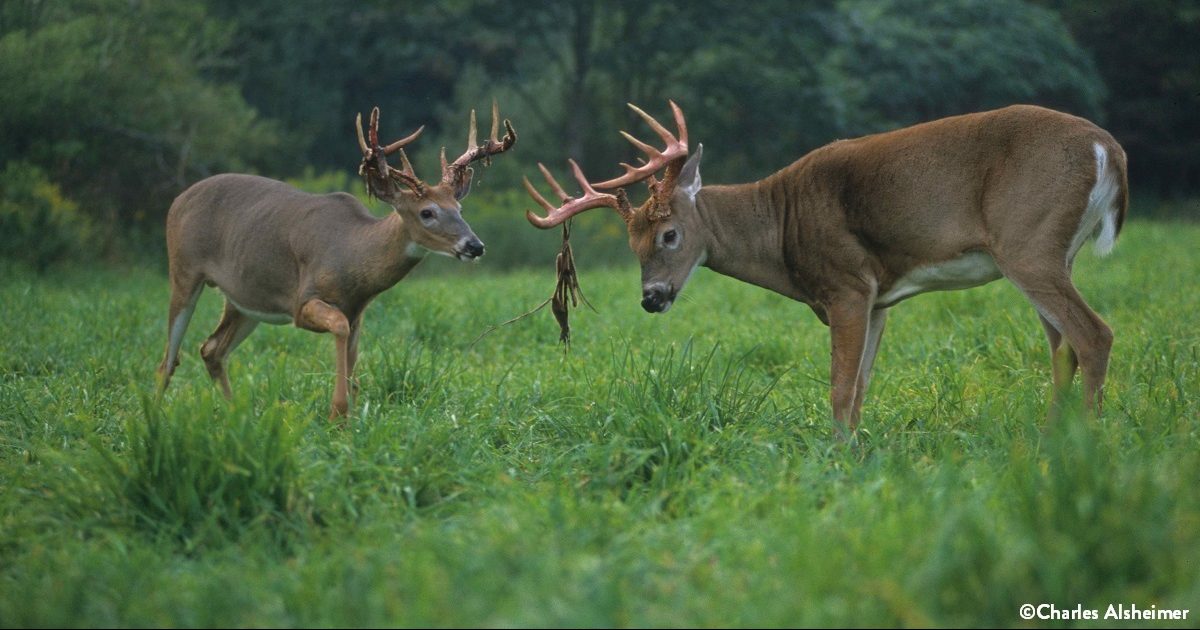The best way to describe the whitetail’s world from August 15 to October 1 can be summed up in two words, what’s next? Their life during this time can move at a snail’s pace or be quite frenetic because of how fast things change as the rut approaches. It’s a fascinating time to be both hunter and observer of whitetails.
 A group of bachelor bucks feed in the same food plot.
A group of bachelor bucks feed in the same food plot.
As mid-August inches toward September both bucks and does are still in their summer patterns with does confined to their family groups and bucks hanging with bucks that make up their bachelor groups. During this time a buck’s home range can easily be less than 1,000 acres and does less than 400. The size of their home range depends on the proximity of their prime bedding and feeding area and the amount of human pressure that’s present. As summer winds down and transitions to autumn it’s not uncommon for bucks to put on 20-25% of their pre-rut body weight because food drives them. About the only thing bucks and does have in common during this time is their tie to the best food sources.
Velvet Peel
 Soon after velvet peel bucks will begin to spar and determine dominance.
Soon after velvet peel bucks will begin to spar and determine dominance.
In most northern reaches of the whitetail’s range velvet peel occurs from late August through the first two weeks of September, with mature bucks usually being the first to shed their velvet. During the peeling process, a buck expends a tremendous amount of energy attempting to rid velvet from his antlers. I’ve photographed many buck fights over the years and few appeared to burn as much energy as the velvet-peeling process does. If a mature buck peels his velvet within 2 hours, he will be physically exhausted by the time he is finished. With antler peel complete and testosterone levels on the rise, rutting behaviors begin to emerge in the form of sparring, scraping and rubbing.
Determining Pecking Order
Dominance among white-tailed deer is progressive and ever-changing. Early September in the North marks the beginning of a host of behaviors that determine which buck in a bachelor group wins the right to rule their summer range come November. With his testosterone valve opening more each day a buck’s quest for dominance is shown by rubbing, scraping, and sparring.
 Two bucks spar in September as they begin to sort out dominance.
Two bucks spar in September as they begin to sort out dominance.
One of the amazing things I learned from 25 years of raising whitetails for behavioral study was their ability to know every whitetail in their core home range through scent. By leaving their own distinct scent on rubs and scrapes bucks are able to telegraph their presence and dominance to all deer in their area. Another way bucks determine dominance is by the attitude they exhibit through aggressive vocalization and physical posturing (like threat walking) when they encounter other bucks.
 This buck scent checks a sign post rub to see who’s been in the area
This buck scent checks a sign post rub to see who’s been in the area
Though rubbing, scraping and aggressive posturing play a huge role in determining dominance, it’s a buck’s ability to show his attitude through sparring which can turn into ugly fights. More often than not it is aggressive sparring that determines who will be the bull of the woods. To the winner go the spoils, with the losers dispersing to find a location where they can become the dominant buck.
In some cases the less dominant bucks may travel several miles before finding an area where they can be king. However, in most cases the dispersal will be less than a mile and a half, with frequent visits back to their summer range as the rut approaches and becomes full-blown.
Doe Behavior
Unlike bucks does and her fawn(s) will not disperse come fall. The matriarch doe will spend the year in their core home range, unless forced to migrate due to severe winter conditions, extreme environmental conditions, or changing food sources. Throughout late August and September, bucks, does, and fawns can be seen feeding together in food sources, with little interaction between the sexes. Most bucks have little interest in does prior to October.
Hunting Early Season Whitetails
 Though it may still feel like summer, setting up an ambush near prime food sources (think food plots) offers the best opportunity to kill an early season buck.
Though it may still feel like summer, setting up an ambush near prime food sources (think food plots) offers the best opportunity to kill an early season buck.
A buck’s relatively low testosterone level and warm temperatures make hunting them from late August (yes, some states allow late August hunting) to the first of October difficult. The best time of day to hunt this period will be the last hour of daylight and on rare occasions the first hour of the morning if the temperature is cool. The beauty of the last hour of daylight is that all deer have been bedded throughout the day and are anxious to get to food sources before nightfall. This, coupled with the fact bucks may still be in their bachelor groups, offers a great opportunity to harvest the buck because their behavior is more predictable than at any other time of the season.






